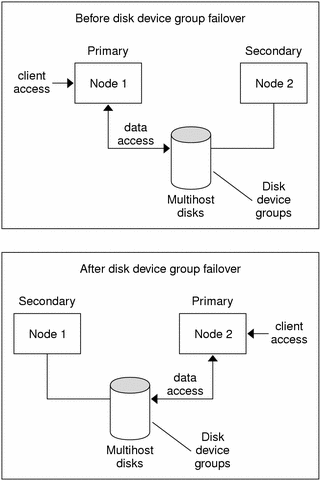Disk Device Groups
In the SunPlex system, all multihost disks must be under control of the Sun Cluster software. You first create volume manager disk groups--either Solstice DiskSuite disk sets or VERITAS Volume Manager disk groups--on the multihost disks. Then, you register the volume manager disk groups as disk device groups. A disk device group is a type of global device. In addition, the Sun Cluster software automatically creates a rawdisk device group for each disk and tape device in the cluster. However, these cluster device groups remain in an offline state until you access them as global devices.
Registration provides the SunPlex system information about which nodes have a path to what volume manager disk groups. At this point, the volume manager disk groups become globally accessible within the cluster. If more than one node can write to (master) a disk device group, the data stored in that disk device group becomes highly available. The highly available disk device group can be used to house cluster file systems.
Note -
Disk device groups are independent of resource groups. One node can master a resource group (representing a group of data service processes) while another can master the disk group(s) being accessed by the data services. However, the best practice is to keep the disk device group that stores a particular application's data and the resource group that contains the application's resources (the application daemon) on the same node. Refer to the overview chapter in the Sun Cluster 3.0 12/01 Data Services Installation and Configuration Guide for more information about the association between disk device groups and resource groups.
With a disk device group, the volume manager disk group becomes "global" because it provides multipath support to the underlying disks. Each cluster node physically attached to the multihost disks provides a path to the disk device group.
Disk Device Group Failover
Because a disk enclosure is connected to more than one node, all disk device groups in that enclosure are accessible through an alternate path if the node currently mastering the device group fails. The failure of the node mastering the device group does not affect access to the device group except for the time it takes to perform the recovery and consistency checks. During this time, all requests are blocked (transparently to the application) until the system makes the device group available.
Figure 3-2 Disk Device Group Failover

- © 2010, Oracle Corporation and/or its affiliates
